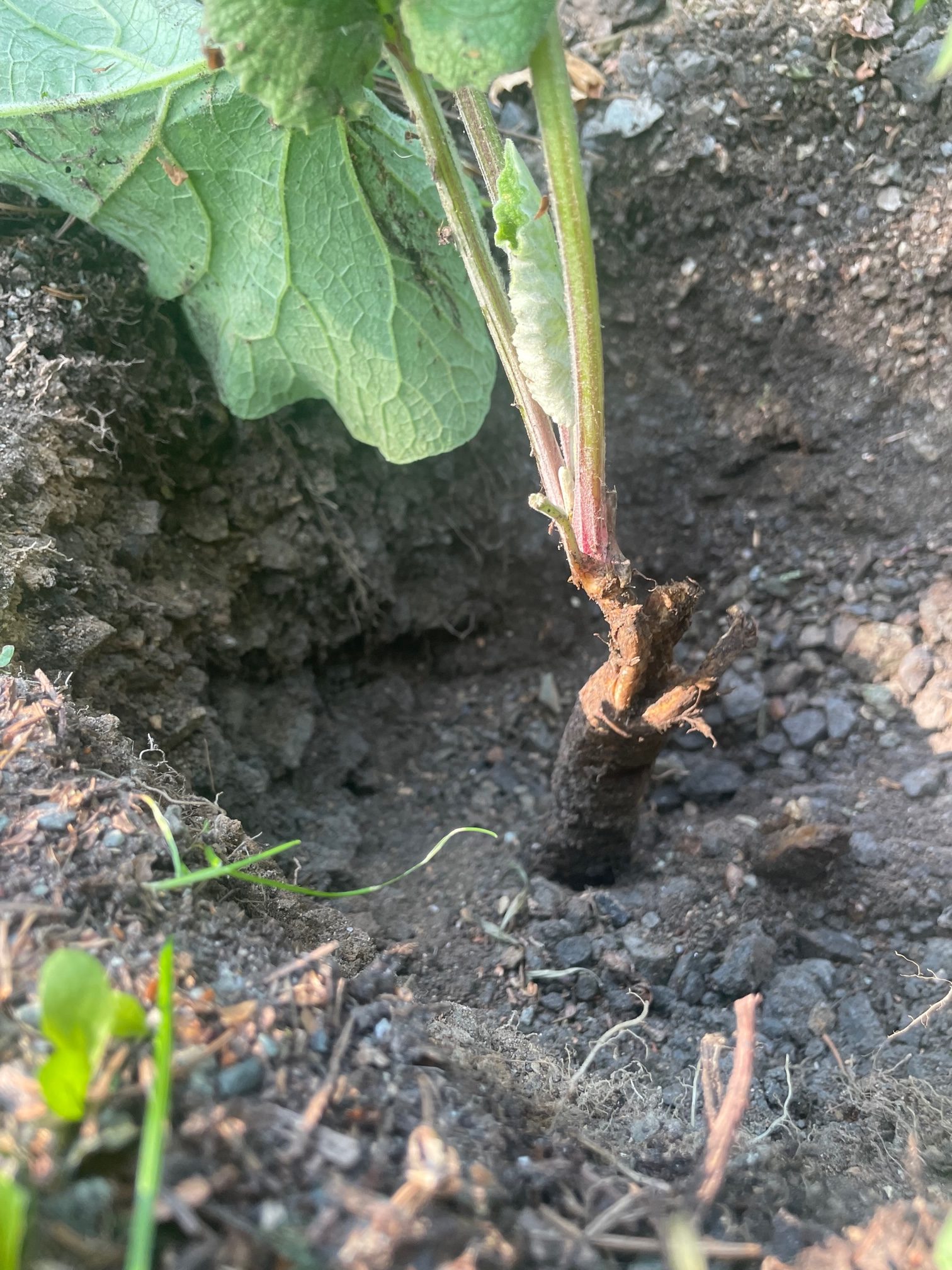Many invasive species in the Sea to Sky are edible or have medicinal qualities. That is, after all, why many of them were brought here in the first place! Common Burdock is an example of one of these edible invasives that can be spotted throughout our region. It does well in disturbed soils, so you will likely find it along roads, in ditches, along trails and near construction sites, to name a few. Common Burdock can be identified by its large, rhubarb-like leaves, or its pesky burs once the plant matures.
While eating Burdock is unlikely to eradicate it completely, it will at least prevent some of its spread! As with other edible invasive plants, please stick to foraging, and do not intentionally plant them in your yard or garden.
Read on for more information on Common Burdock and how to collect it, as well as a recipe for roasted burdock root.
Common Burdock
Common Burdock is a biennial plant, with large leaves forming a rosette in its first year, and growing up to 3 m tall in its second year. However, there is evidence that Common Burdock can act as a short-lived perennial, surviving several years before flowering.
Common Burdock has large, green heart-shaped leaves with wavy edges and hairs on the undersides. The stems are grooved and are sometimes reddish near the base. As the plant matures, its fleshy taproot begins to grow woodier, and the plant overall gets taller, forming many branches on which grow hooked burs. These burs begin green, drying out and turning brown later in the year.
A single Common Burdock plant can produce 6,000-16,000 seeds (which are housed in its burs), making it a prolific spreader. Introduced to North America from Europe in 1638, it thrives in most conditions and disturbed areas. Common Burdock outcompetes and outshades native plants, which reduces local biodiversity. Birds and bats can become ensnared in the dry burs and die, and it taints the taste of milk if livestock graze on its leaves. Common Burdock is sometimes confused with a similar edible invasive, Curled Dock. While their leaves look similar, Curled Dock leaves are smaller and less hairy than Common Burdock’s, and it does not produce burs.
Several parts of Common Burdock are edible. Leaves are said to be very bitter, but the leaf stem is edible if peeled. Stems can be eaten raw or added to stir-fries or stews. Tall second-year stems that have not yet flowered are also edible. They are said to taste milder – simply peel back the tough outer skin to get to the tender core.

First-year Common Burdock

Second-year Common Burdock with flowers

Mature Common Burdock burs
Collecting Common Burdock roots
Collecting Common Burdock roots is fairly straightforward once you have all of the right tools. Their large leaves make them easy to spot along the sides of trails and forested areas. Remember to follow our recommendations for best practices when foraging or collecting wild invasives.
Only the taproots from young, first-year plants should be eaten. The mature second-year plants have tough, woody taproots that aren’t very tasty.
Digging is the most effective way to get the entire taproot. Using a large shovel, dig at least 30cm deep around the young plant before pulling it up. Leftover pieces of root in the soil will sprout and grow into new individuals, spreading this invasive species, so make sure you dig out the entire taproot!
Remove the leaves from the thick taproot. Remember to dispose of all unwanted plant parts in the garbage, not the compost. Wash the roots well to remove all dirt, and peel as you would a carrot, if desired.

Common Burdock Taproot
Roasted Burdock root recipe

Adapted from recipe by Grow Forage Cook Ferment
Ingredients
- about 1 lb. Common Burdock root
- 2 tbsp olive oil
- salt and pepper to taste
- 1 tbsp soy sauce or tamari (optional for serving)
- 1 tsp sesame seeds (optional for serving)
Instructions
- Preheat oven to 400F.
- Thoroughly wash your burdock root to remove all dirt, and peel if desired. Slice into 2 cm rounds. The rounds will begin to discolour the longer they are exposed to air – work quickly to avoid this.
- In a large bowl, toss the sliced burdock root with the olive oil, salt, and pepper.
- Lay out the sliced burdock root on a sheet pan. Roast for 30 minutes or until the burdock root is golden brown, flipping halfway.
- Toss roast burdock root with soy sauce or tamari and sesame seeds, and enjoy!


Add Comment